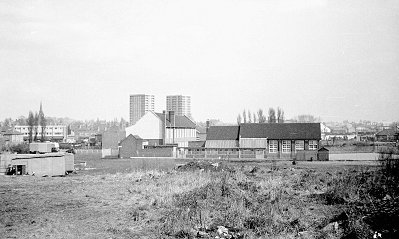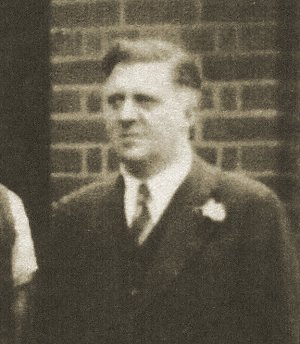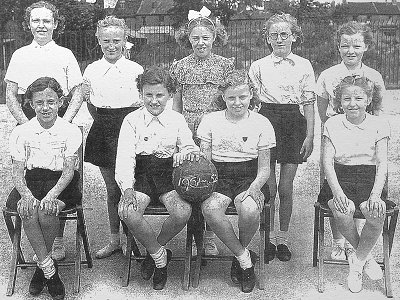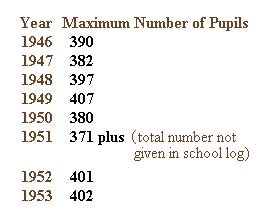| After the war the school could finally get back to
normality. When the school reopened after the summer
holiday on 11th September, 1945 there were 390 pupils
and a new teacher, Miss Marshall, who had recently
qualified at Bingley Training College. Thoughts were
turning towards the provision of a school playing field,
and this is recorded in the school log book. Mr. Gorse
H.M.I. was called to a meeting at the school on 3rd
October 1945 to discuss the matter. It seems that this
would have been unlikely to happen during the war, and
so the school took the first opportunity to explore the
possibility.
Teachers and classes in the 1940s:
|
Head Teacher - Mr. Thacker |
|
Class |
|
Teacher |
|
8 |
|
Miss
Constable, Mrs. Foster née Gibbs |
|
7 |
|
Miss
Proverbs, Miss Fletcher |
|
6 |
|
Mrs.
Hill |
|
5 |
|
Miss
Sharpe |
|
4 |
|
Mrs.
Walters née Marshall |
|
3 |
|
Miss
Haigh |
|
2 |
|
Miss
Higgs, Mr. Scarth |
|
1 |
|
Mr.
Hudson |
The class numbers were in reverse
order, starting with class 8 for the newly admitted
infants, through to class 1 for the final year
juniors.
1946 saw the introduction of free
school milk, a measure to improve the health of
under 18 year olds, who were entitled to one-third
of a pint each day. It proved to be a great success,
contributing to a reduction in rickets, and child
deaths from diphtheria, measles, scarlet fever and
whooping cough. The importance of school meals was
made apparent in October, 1947 when a meals enquiry
revealed that 220 out of 345 children would require
school meals if enough were available.
The many health visits from the
school doctor and school nurse continued. Newly
admitted infants were examined, as were the final
year leavers. All pupils were checked for
cleanliness, particular attention being paid to
hands and hair. Dental tests and eye tests were also
carried out and any child doing badly in the eye
test would be sent to the eye clinic to see a
specialist.
|
|

A view of the school from the top
of the old pit bank. |
There were also the selection tests for the
leavers, consisting of two intelligence tests, tests in
arithmetic and English, and an oral exam for scholarship
candidates. The second stage selection test for boys
and girls was often held at Slater Street Secondary
Modern School. |
| The school log book records one of the county's
coldest winters, which began with two short spells of
severe weather. The first cold spell around the 16th
December, 1946 was followed by a heavy fall of snow on
6th January, 1947, the first day at school after the
Christmas break. Things went from bad to worse when
heavy snow and very low temperatures persisted from 21st
January until 16th March.
During the cold snap the attendance figures were
poor, due to outbreaks of chicken pox, measles and
colds. Members of staff were also absent and on the 11th
and 12th of February there was no school milk because
Walsall Coop assumed that all schools were closed. The
log book records that it was still intensely cold on
24th February, and a very heavy snow fall occurred on
26th February. |

| Mr.
Thacker. Courtesy of Sue Harper,
Gill Broomhall and Maureen Page. |
|
|
On 5th March a blizzard raged all day
causing many members of staff to be late arriving.
Problems were also caused on the 13th March by snow and
ice on the roads. The weather problems were aggravated
by the fuel and food shortages which remained for some
years after the war. It must have been a great relief
when spring finally came, just before the Easter
holiday. On the school's return from holiday, in April,
Mr. Thacker had to turn down an application from parents
in Moxley who wanted their children to be admitted to
the school. At the time the school had 401 children and
so could take no more.
Although the following winters were
not so severe, poor attendances were not uncommon.
In January 1951 there were outbreaks of measles,
chicken pox, whooping cough, colds and influenza.
One school tradition that I haven't yet mentioned is
the annual sports afternoon. This would be an
important occasion for children and parents alike.
Many events would be organised and there would be
great competition between the school's best
athletes, proudly watched by their parents. Prizes
were awarded to the winners and an enjoyable time
would be had by all. In the school's early years the
event either took place in George Rose Park, or the
school playground, and in 1938 and 1939 the school
competed in Darlaston Junior Schools Sports.
It appears that during the war years the
event didn't always take place, as it isn't recorded in
the school log book in 1943, 1944, 1945 or 1946. In the
following years the event would often be held on Guest,
Keen and Nettlefolds' sports ground in Hall Street, the
first such occasion being on 11th June, 1947. By 1950 it
had become a popular event as that year around 200
parents came along. It was described as a great success.
In June 1953 the school won the athletics cup at the
Darlaston Inter-Schools Sports, to be followed in July
by another success when Anthea Waring retained the
Primary Girls' Championship Cup for the school at the
S.E. Staffs Swimming Gala.

Mr. Scarth and his
class from 1951. Courtesy of Valerie Allen,
Sue Harper,
Gill Broomhall and Maureen Page.
Names Left to Right:
Back Row Mr. Scarth, Valerie
Carter, Betty Lowe, Brian Mann, Pauline
Wilkes, John Dangerfield, Valerie Halsbury,
Peter Hickin, All Carless, Harold Fielder,
Pat Partridge, Doreen Ridge.
3rd Row Irene Brookes,
Peter Shirley, Irene Parker, Godfrey Baker,
Maureen Hammond, Keith Marsden, Marion
Fiddler, John Dowen, ?, Alan Butler, Anthea
Wearing.
2nd Row Stan Cannadine,
Linda Holland, Jean Dent, Brian Webster,
Harry Cornforth, Stanley Beardsmore, ?, John
Millard, Brian Hesson, Derek Hingley, Brenda
Talbot, June Sidebottom, Janet Lloyd.
Front Row Michael
Arblaster, Valerie Rose, Dorothy Bedworth,
Billy Mansell, Colin Cherrington, ?, Pauline
Siverns, Pat Thompson, Billy Rollinson, Pat
Spencer, Keith Statham. |
The traditional September harvest
festival continued after the war, and in 1947 a sale of
produce raised £13.18s.0d. which went towards the
Christmas tea party, where there was a plentiful supply
of food, thanks to help from the parents. In December
1949 a series of plays were presented to the school by
different classes. Plays took place on 14th, 15th, 16th,
and 19th of the month. The idea was repeated on 15th
December, 1952 when performances of plays were given to
the school by classes 4, 6, 7, and 8, and on December
16th by classes 1, 2, and 3.
During the Whitsuntide holiday in
1948 a tragic event took place. One of the younger
children, J. George Page from class 8 drowned in a
local canal. Another important school event was the
annual school trip. On 23rd June, 1948 children from
classes 1 and 2 went on a coach trip to Kenilworth
and Stratford-upon-Avon, with Mr. Hudson and Mr.
Scarth in charge. On 22nd June, 1950 the two classes
went to Ludlow and Bewdley. It is reported as being
a very interesting and profitable journey. The
following year they travelled again to Stratford.
Another interesting event took place on 19th
October, 1948 when students from Nelson Hall
Training College gave a display of Morris dancing to
the children, in the hall.
|

Pinfold Street School football
team 1952 to 1953. Courtesy of Sue Harper,
Gill Broomhall and Maureen Page.
Names
Left to Right:
Back Row Mr. Scarth, Mr. Hudson.
3rd
Row Bill Bradley, Colinn Pincher,
J. Millard, Alan Cooper, Jeff Lowe, A. Bytheway.
2nd
Row Ken Dangerfield, ?, Len
Moreton, John Russell, Tony Cooksey.
Front
Row Mickey Arblaster, Roy Howell. |
|
Other events included a successful
and highly enjoyable visit to the Festival of
Britain exhibition in London, on 31st May 1951. 19
pupils and their parents attended along with some of
the staff. Three weeks later on 20th and 21st June
open days were held at the school for pupils and
parents. In 1953 the school managers formed a
Coronation sub-committee to arrange events to
celebrate the Coronation, and the L.E.A. provided a
grant of £38.8s.7d. towards expenses. Events
included a Coronation party on 28th May, followed on
the 29th by an open day for parents, who were
entertained by the juniors with a concert of songs
and poems. The events ended on 22nd June with a
school visit to the Regal Cinema to see the
Coronation film "Elizabeth is Queen".
Further events included a display
about road safety, held in the playground on 23rd
June, 1953 which used dogs. The annual school trip
on the following day went to Whipsnade Zoo. 112
children and their parents attended, along with
members of the school staff.
All of the children took part in
sports lessons, then called P.T. (physical
training). There were athletics in the playground
and gymnastics in the hall. The school acquired P.T.
mats, rounder posts and bases, and eleven 18inch
skittles. The lessons were occasionally observed by
the visiting P.T. supervisor, Miss Blanchard. She
also organised swimming classes at Darlaston
Municipal Baths. In 1949 the girls commenced their
course of swimming instruction on Wednesday
afternoons at 3.30, followed by the boys on Fridays
at 1.45.
|
|

The 1951 to 1953 school netball
team. Courtesy of Valerie Allen, Sue Harper,
Gill Broomhall and Maureen Page.
Names
Left to Right:
Back Row Marion Fiddler, Valerie Malsbury,
Gillian Folls, Irene Brookes, Sheila Hurley.
Front
Row Anthea Wearing, Pat Thompson, Pauline
Davies, Gladys Randall. |
|
In 1949 schools in the area began to
appoint clerical assistants to greatly ease some of
the headmaster's duties. In May Mr. Thacker attended
a meeting at Slater Street School about clerical
assistance and on 13th June Mrs. M. Wallis was
appointed to the new post. She commenced her duties
on 20th June and worked on Monday and Thursday
mornings.
Mrs. Wallis stayed at the school for
5 months and was replaced by Mrs. M. Hudson, who
stayed for just over a year. On 19th February, 1951
Mrs. Lewis began her duties as school secretary. She
worked at the school for many years and will fondly
be remembered by a large number of ex-pupils
including myself.
Telephones are now an everyday part of
life and it would seem very strange without them. This
was not the case however in the 1950s and this can be
seen from a couple of entries in the school log book.
The school was without a telephone until 13th September,
1951. The first telephone call was made to Wednesbury on
October 1st. The school continued to invest in
technology with the purchase of a radio licence on 5th
October, which cost £1.
On 20th May, 1953 the school
received its first flagpole which was given by the
chairman of the school managers, Mr. E. Ward.
The school saving scheme had continued to operate
since the late 1930s. On 9th December, 1952 Mr. A.
G. B. Owen visited the school to present the
flag for national savings to the most successful
class. This was class1 who saved a total of
£151.16s.6d. |

The variation in post-war pupil numbers.
|
By early 1951 Mr. Thacker was beginning
to suffer from prostate problems. His entries in the
school log book record the deterioration in his
handwriting, presumably due to his illness. On the 8th
of May he entered Dudley Road Hospital, Birmingham for
an operation. He returned to the school after his
operation and convalescence on 16th July. He had not
properly recovered and was still very weak. His
illness persisted until his resignation on 14th May,
1953. In his absence his wife was presented, with a
cheque for £21 and a chiming clock on behalf of the
school. In June 1954 Mrs. Thacker presented the prizes
at the school sports.
Mr. Thacker passed away after his long
illness in May 1956. His funeral was attended by Miss
Haigh, Mr. Mayland and Mr. Scarth. Wreathes were sent by
the staff and pupils. He was a popular headmaster and is
well remembered by many old pupils.
|
 |
|
 |
|
 |
Return to
The War Years |
|
Return to the
beginning |
|
Proceed to A
New Headmaster |
|